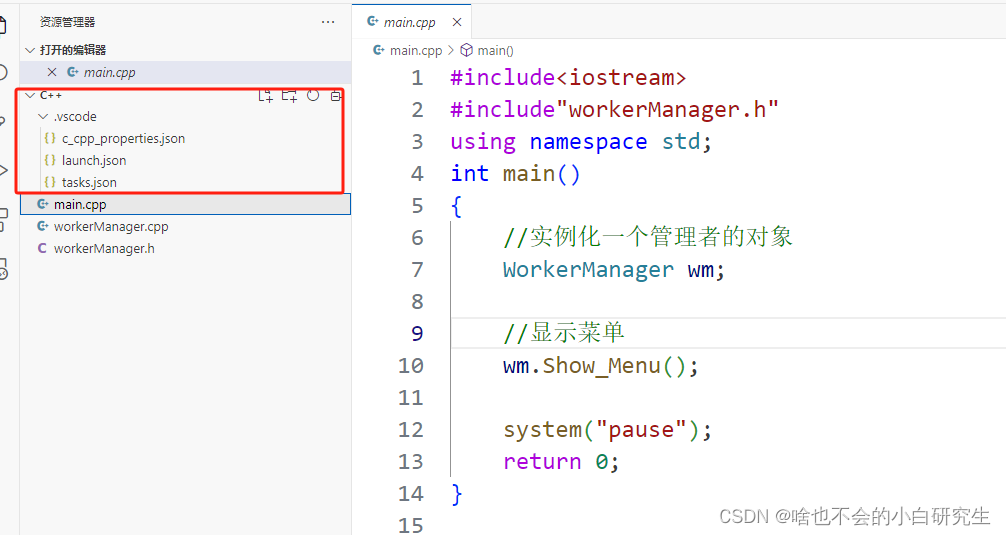前言
figures.zip · LiangCha_Xyy/Source – Gitee.com
如下图,.tex文件和figures文件夹放在同一路径下即可
.tex代码
documentclass[UTF8]{ctexart}
usepackage{listings}
usepackage{xcolor}
usepackage{booktabs} %绘制表格
usepackage{caption2} %标题居中
usepackage{geometry}
usepackage{amsmath}
usepackage{amsfonts}
usepackage{amssymb}
usepackage{subfigure}
usepackage{longtable}
usepackage{float}
usepackage{graphicx}
usepackage{booktabs}
usepackage{indentfirst}
usepackage{setspace}
usepackage{adjustbox}
graphicspath{{figures/}}
geometry{a4paper,left=2.5cm,right=2.5cm,top=2.5cm,bottom=2.5cm}
setlength{parindent}{0em}
lstset{
numbers=left, %设置行号位置
numberstyle=tiny, %设置行号大小
keywordstyle=color{blue}, %设置关键字颜色
commentstyle=color[cmyk]{1,0,1,0}, %设置注释颜色
escapeinside=``, %逃逸字符(1左面的键),用于显示中文
%breaklines, %自动折行
extendedchars=false, %解决代码跨页时,章节标题,页眉等汉字不显示的问题
xleftmargin=1em,xrightmargin=1em, aboveskip=1em, %设置边距
tabsize=4, %设置tab空格数
showspaces=false %不显示空格
}
title{ }
author{自己的名字}
renewcommand{thesubsection}{thesection.arabic{subsection}}
begin{document}
begin{titlepage}
centering
vspace*{4cm} % 调整标题与图片的垂直间距
includegraphics[scale=0.08]{logo.png} \
{Huge Beijing University of Chemical Technology\} % 使用 Huge 调整字体大小
{Huge Computing Methods\ }
rule{15cm}{1.2pt}
{Hugebfseries 计算方法课程实验\}
rule{15cm}{1.2pt} \[2cm] % 调整标题与作者信息之间的垂直间距
{Large 名字\[1cm]} % 调整作者信息的垂直间距
{Large 日期\}
end{titlepage}
%实验二
section{Lagrange插值方法}
subsection{实验目的}
(1)熟悉简单的一阶和二阶 Lagrange插值方法;\
(2)学会计算 Lagrange基函数;\
(3)正确构造插值多项式;\
(4)对插值结果进行合理分析;\
subsection{实验原理}
$p_n(x)=sum_{k=0}^n y_k l_k(x)=sum_{k=0}^nleft(prod_{substack{j=0 \ j neq k}}^n frac{x-x_j}{x_k-x_j}right) y_k$ \
subsection{实验环境}
Windows 10 + Visual Studio\
subsection{实验内容}
setstretch{1.5}
centering
begin{tabular}{|l|l|}
hline$x$ & $f(x)$ \
hline 24 & 1.888175 \
26 & 1.918645 \
28 & 1.947294 \
30 & 1.961009 \
hline
end{tabular} \
表 1.1: 数据样本表\
vspace{0.5cm} % 插入垂直空白
使用 Lagrange插值多项式计算 f(25),f(27),f(29),并给出插值多项式。\
修改程序直至运行成功,查看运行结果,并和如下真实值进行比较。\
vspace{0.5cm} % 插入垂直空白
begin{tabular}{|l|l|}
hline$x$ & $f(x)$ \
hline
25 & 1.90365393871587 \
27 & 1.933182044931763 \
29 & 1.961009057454548 \
hline
end{tabular} \
表 1.2: 数据真实值\
raggedright %左对齐
vspace{5cm}
subsection{程序代码}
begin{lstlisting}[language=C++,basicstyle=small]
#include<iostream>
#include<cmath>
using namespace std;
int main()
{
//输入程序
int m;
cout<<"请输入有几个采样点:"<<endl;
cin>>m;
pair<double,double> points[m];
for(int i=0;i<m;i++){
double x,y;
cout<<"插值点:";
cin>>x>>y;
points[i] = {x,y};
cout<<endl;
}
//程序处理
int n;
cout<<"请输入待预测的点的个数:"<<endl;
cin>>n;
for(int i=0;i<n;i++){
double x_pred;
cin>>x_pred;
double res = 0;
for(int j=0;j<m;j++){ // 使用 m 而不是 n
double a = 1, b = 1;
for(int k=0;k<m;k++){ // 修改内层循环变量名为 k
if(j!=k){
a *= (x_pred - points[k].first);
b *= (points[j].first - points[k].first);
}
}
res += a * points[j].second / b;
}
cout<<"插值点:(x,y)=("<<x_pred<<","<<res<<")"<<endl;
}
}
end{lstlisting}
vspace{5cm}
运行结果如下:\
includegraphics[scale=0.8]{output1.png} \
%实验二
section{牛顿插值方法}
subsection{实验目的}
(1)理解牛顿插值方法;\
(2)学会计算差商;\
(3)正确构造插值多项式;\
(4)设计程序并调试得到正确结果;
subsection{实验原理}
$fleft(x_0, x_1, cdots, x_nright)=sum_{k=0}^n frac{fleft(x_kright)}{prod_{substack{j=0 \ j neq k}}^nleft(x_k-x_jright)}$ \
$n$ 次插值多项式:\
$
begin{aligned}
p_{n}(x) & =fleft(x_0right)+fleft(x_0, x_1right)left(x-x_0right)+fleft(x_0, x_1, x_2right)left(x-x_0right)left(x-x_1right)+cdots \
& +fleft(x_0, x_1, cdots, x_nright)left(x-x_0right)left(x-x_1right) cdotsleft(x-x_{n-1}right)
end{aligned}
$
subsection{实验环境}
Windows 10 + Visual Studio
subsection{实验内容}
计算以下积分值:\
setstretch{1.5}
centering
$$
begin{array}{|c|c|c|c|c|c|}
hline x & 0.4 & 0.55 & 0.65 & 0.8 & 0.9 \
hline f(x) & 0.41075 & 0.57815 & 0.69675 & 0.88811 & 1.02652 \
hline
end{array}
$$
raggedright %左对齐
subsection{程序代码}
begin{lstlisting}[language=C++,basicstyle=small]
#include<iostream>
#include<cmath>
using namespace std;
const int N = 4;//插值点数-1
pair<double,double>points[]={{0.4,0.41075},{0.55,0.57815},
{0.65,0.69675},{0.8,0.88811},{0.9,1.02652}};
//差商计算 + 数据点更新
void func(int n)
{
double f[n];//差商表
for(int k=1;k<=n;k++){
f[0] = points[k].second;
for(int i=0;i<k;i++)
f[i+1] = (f[i]-points[i].second)/(points[k].first-points[i].first);
points[k].second = f[k];
}
}
int main()
{
double x = 0.895;
double b = 0;
func(N);
for(int i=N-1;i>=0;i--){
b = b*(x-points[i].first)+points[i].second;
cout<<b<<endl;
}
cout<<"Nn("<<x<<")="<<b<<endl;
}
end{lstlisting}
运行结果如下:\
includegraphics[scale=1]{output2.png} \
vspace{5cm}
section{Newton-Cotes方法}
subsection{实验目的}
(1)掌握Newton-Cotes算法;\
(2)要求程序不断加密对积分区间的等分,自动地控制Newton-Cotes算法中的加速收敛过程;\
(3)编写程序,分析实验结果;
subsection{实验原理}
设将求积区间 $[a, b]$ 划分为 $n$ 等分, 选取等分点
$$
x_i=a+i h, quad h=frac{b-a}{n}, quad i=0,1,2, cdots, n
$$
作为求积节点构造求积公式
$$
int_a^b f(x) d x approx(b-a) sum_{i=0}^n lambda_i fleft(x_iright)
$$
subsection{实验环境}
Windows 10 + Visual Studio
subsection{实验内容}
$begin{aligned}
& mathrm{I}=int_0^frac{1}{4} sqrt{4-sin^2x} d x quad(I approx 0.4987111175752327) \
& mathrm{I}=int_0^1 frac{sin x}{x} d x quad(f(0)=1, quad I approx 0.9460831) \
& mathrm{I}=int_0^1 frac{e^x}{4+x^2} d x \
& mathrm{I}=int_0^1 frac{ln (1+x)}{1+x^2} d x
end{aligned}$
subsection{程序代码}
begin{lstlisting}[language=C++,basicstyle=small]
#include<iostream>
#include<cmath>
using namespace std;
#define MAXSIZE 7
long c[MAXSIZE][MAXSIZE+5] = {{2,1,1}, {6,1,4,1}, {8,1,3,3,1},
{90,7,32,12,32,7}, {288,19,75,50,50,75,19},
{840, 41,216,27,272,27,216,41},
{17280,751,3577,1323,2989,2989,1323,3577,751}};
double func(double x) //原函数
{
return log(1+x)/(1+x*x);
}
int main()
{
cout<<"计算3.4函数积分值"<<endl;
double a,b;
int n;
cout<<"请输入积分边界:";
cin>>a>>b;
cout<<"请输入积分节点数:";
cin>>n;
double h = (b-a)/(n-1);
double f[n],x[n];
for(int i=0;i<n;i++){//计算积分节点纵坐标
x[i] = a+i*h;
f[i] = func(x[i]);
}
double integral = 0;//积分值
for(int i=0;i<n;i++){
integral += c[n-2][i+1]*func(x[i]);
}
integral *= (b-a)/c[n-2][0];
printf("积分值为=%lf", integral);
}
end{lstlisting}
运行结果如下:\
begin{figure}[ht]
centering
begin{adjustbox}{width=0.24textwidth,height=2cm}
includegraphics{output31.png}
end{adjustbox}
begin{adjustbox}{width=0.24textwidth,height=2cm}
includegraphics{output32.png}
end{adjustbox}
begin{adjustbox}{width=0.24textwidth,height=2cm}
includegraphics{output33.png}
end{adjustbox}
begin{adjustbox}{width=0.24textwidth,height=2cm}
includegraphics{output34.png}
end{adjustbox}
caption{计算函数积分值}
end{figure}
subsection{实验分析}
begin{figure}[ht]
centering
includegraphics[scale=0.42]{py.png}
caption{函数(3.1)的图像}
end{figure}
应用 Newton-Cotes 公式得到近似积分值为:\
$$I = 0.498711$$
积分精确值为 0.4987111175752327,由此可见两者是非常接近的
section{求非线性方程根的牛顿法}
subsection{实验目的}
(1)掌握求非线性方程根的牛顿法;\
(2)进一步了解牛顿法的改进算法;\
(3)编写程序,分析实验结果;
subsection{实验原理}
牛顿法迭代公式为:\
$$
x_{k+1}=x_k-frac{fleft(x_kright)}{f'left(x_kright)}
$$
subsection{实验环境}
Windows 10 + Visual Studio\
subsection{实验内容}
用牛顿迭代法求$ xe^x − 1 = 0 $的根,迭代初始值为 $x_0 = 0.5。$
raggedright %左对齐
subsection{程序代码}
begin{lstlisting}[language=C++,basicstyle=small]
#include<iostream>
#include<cmath>
using namespace std;
double f(double x)//原函数
{
return x*exp(x)-1;
}
double df(double x)//导函数
{
return exp(x) + x*exp(x);
}
int main()
{
double x;
double eplison;
cout<<"请输入精度要求:"<<endl;
cin>>eplison;
cout<<"请输入迭代初值:"<<endl;
cin>>x;
double x0 = x;
double x1 = x0 - f(x0)/df(x0);
while(fabs(x1-x0)>eplison){
double temp = x1;
x1 = x0 - f(x0)/df(x0);
x0 = temp;
}
cout<<"f(x)=0的根x="<<x1<<endl;
}
end{lstlisting}
运行结果如下:\
includegraphics[scale=1]{output4.png} \
section{解线性方程组的迭代法}
subsection{实验目的}
(1) 掌握雅可比迭代和 Seidel 迭代来求解方程组;\
(2) 掌握常用的几种迭代格式;\
(3) 编写程序实现上述迭代方法;\
(4) 分析实验结果,并估计误差;
subsection{实验原理}
有如下线性方程组 Ax = b 如下:\
$$
left(begin{array}{cccc}
a_{11} & a_{12} & cdots & a_{1 n} \
a_{21} & a_{22} & cdots & a_{2 n} \
vdots & vdots & ddots & vdots \
a_{n 1} & a_{n 2} & cdots & a_{n n}
end{array}right)left(begin{array}{c}
x_1 \
x_2 \
vdots \
x_n
end{array}right)=left(begin{array}{c}
b_1 \
b_2 \
vdots \
b_n
end{array}right)
$$
使用迭代法进行求解,主要迭代方法为雅可比迭代和 Gauss-Seidel 迭代\
subsection{实验环境}
Windows 10 + Visual Studio\
subsection{实验内容}
使用高斯-赛德尔迭代法求解下列方程组:\
$
left{begin{array}{l}
10x_1 - x_2 - 2x_3 = 7.2 \
-x_1 + 10x_2 - 2x_3 = 8.3 \
-x_1 - x_2 + 5x_3 = 4.2 \
end{array}right.
$
subsection{程序代码}
begin{lstlisting}[language=C++,basicstyle=small]
#include <iostream>
using namespace std;
void input(int n, double b[], double **coefficient){
cout<<"请输入系数矩阵:"<<endl;
for(int i=0;i<n;i++){
for(int j=0;j<n;j++) cin>>coefficient[i][j];
}
cout<<"请输入常数矩阵:";
for(int i=0;i<n;i++) cin>>b[i];
}
int main()
{
int n;
double epsilon;
cout << "请输入未知数个数:";
cin >> n;
double b[n];
double x0[n];
double x1[n];
double **coefficient = new double*[n];
for (int i = 0; i < n; i++) {
coefficient[i] = new double[n];
}
input(n, b, coefficient);
cout<<"请输入迭代初值:";
for(int i=0;i<n;i++) cin>>x0[i];
cout<<"请输入精度要求:";
cin>>epsilon;
while(true){
for(int i=0;i<n;i++){
double res = 0;
for(int j=0;j<=i-1;j++){
res += coefficient[i][j]*x1[j];
}
for(int j=i+1;j<=n;j++){
res += coefficient[i][j]*x0[j];
}
x1[i] = (b[i]-res)/coefficient[i][i];
}
if(abs(x1[0]-x0[0])<epsilon) break;
for(int i=0;i<n;i++) x0[i] = x1[i];
}
cout<<"解为:";
for(int i=0;i<n;i++) cout<<x1[i]<<" ";
for (int i = 0; i < n; i++) {
delete[] coefficient[i];
}
delete[] coefficient;
return 0;
}
end{lstlisting}
运行结果如下:\
includegraphics[scale=1]{output5.png} \
section{线性方程组的高斯消元法}
subsection{实验目的}
(1) 掌握高斯消元法求解方程组;\
(2) 掌握列主元高斯消元法求解方程组;\
(3) 分析实验结果,并估计误差;
subsection{实验原理}
有线性方程组 Ax = b \
$
left{begin{aligned}
x_n & =frac{b_n^{(n)}}{a_{n n}^{(n)}} \
x_i & =frac{b_i^{(i)}-sum_{j=i+1}^n a_{i j}^{(i)} x_j}{a_{i i}^{(i)}} quad i=n-1, n-2, n-3, cdots, 2,1
end{aligned}right.
$
subsection{实验环境}
Windows 10 + Visual Studio\
subsection{实验内容}
使用高斯消元法求解下列方程组:\
$$
left{begin{array}{l}
10 x_1-x_2-2 x_3=7.2 \
-x_1+10 x_2-2 x_3=8.3 \
-x_1-x_2+5 x_3=4.2
end{array}right.
$$
subsection{程序代码}
begin{lstlisting}[language=C++,basicstyle=small]
#include <iostream>
using namespace std;
void input(int n, double b[], double **a){
cout<<"请输入增广矩阵:"<<endl;
for(int i=1;i<=n;i++){
for(int j=1;j<=n;j++) cin>>a[i][j];
cin>>b[i];
}
}
int main()
{
int n;
cout << "请输入未知数个数:";
cin >> n;
double b[n+1];
double **a = new double*[n+1];
for (int i = 0; i <=n; i++) {
a[i] = new double[n+1];
}
input(n,b,a);
for(int k=1;k<=n;k++){
for(int j=k+1;j<=n;j++)
a[k][j]/=a[k][k];//计算行乘子
b[k]/=a[k][k];
for(int i=k+1;i<=n;i++){
for(int j=k+1;j<=n;j++){
a[i][j]-=a[i][k]*a[k][j];
}
}
for(int i=k+1;i<=n;i++) b[i]-=a[i][k]*b[k];
}
for(int i=n-1;i>=1;i--){
double temp = 0;
for(int j=i+1;j<=n;j++) temp+=a[i][j]*b[j];
b[i] -= temp;
}
cout<<"解为:";
for(int i=1;i<=n;i++) printf("%.4lf ",b[i]);
for (int i =0;i<=n; i++) {
delete[] a[i];
}
delete[] a;
return 0;
}
end{lstlisting}
运行结果如下:\
includegraphics[scale=1]{output6.png} \
section{线性方程组的矩阵分解法}
subsection{实验目的}
(1) 掌握采用矩阵 LU 分解方法来求解线性方程组;\
(2) 编程实现矩阵 LU 分解算法;
subsection{实验原理}
矩阵的 LU 分解定理:\
设A为n阶方阵,如果A的顺序主子矩阵 $A_1, A_2, · · · , A_{n-1}$均非奇异,则A可分解为一个单位下三角矩阵L和一个上三角矩阵U的乘积,即A = LU,且这种分解是唯一的。\
其中 L 和 U 的计算公式为:\
$$
left{begin{array}{l}
u_{1 j}=a_{1 j}, quad j=1,2,3, cdots, n \
l_{i 1}=frac{a_{i 1}}{u_{11}}, quad i=2,3,4, cdots, n \
u_{i j}=a_{i j}-sum_{k=1}^{i-1} l_{i k} u_{k j}, quad j=i, i+1, cdots, n \
l_{i j}=frac{a_{i j}-sum_{k=1}^{j-1} l_{k k} u_{k j}}{u_{j j}}, quad j=1,2, cdots, i-1
end{array}right.
$$
subsection{实验环境}
Windows 10 + Visual Studio\
subsection{实验内容}
(1) 写出矩阵 LU 分解法解线性方程组算法,编一程序上机调试出结果,要求所编程序适用于任何一解线性方程组问题,即能解决这一类问题,而不是某一个问题。\
(2) 使用矩阵 Doolittle 分解法求解下列方程组:\
$$
left{begin{array}{l}
10 x_1-x_2-2 x_3=7.2 \
-x_1+10 x_2-2 x_3=8.3 \
-x_1-x_2+5 x_3=4.2
end{array}right.
$$
subsection{程序代码}
begin{lstlisting}[language=C++,basicstyle=small]
#include <iostream>
using namespace std;
void input(int n, double b[], double **a){
cout<<"请输入增广矩阵:"<<endl;
for(int i=0;i<n;i++){
for(int j=0;j<n;j++) cin>>a[i][j];
cin>>b[i];
}
}
int main()
{
int n;
cout << "请输入未知数个数:";
cin >> n;
double b[n+1];
double **a = new double*[n+1];
for (int i = 0; i <=n; i++) {
a[i] = new double[n+1];
}
double l[n+1][n+1],u[n+1][n+1];
double x[n+1],y[n+1];
input(n,b,a);
for(int i=0;i<n;i++) l[i][i] = 1;
//LU分解
for(int k=0;k<n;k++){
for(int j=k;j<n;j++){
u[k][j] = a[k][j];
for(int i=0;i<=k-1;i++){
u[k][j] -= (l[k][i]*u[i][j]);
}
}
for(int i=k+1;i<n;i++){
l[i][k] = a[i][k];
for(int j=0;j<=k-1;j++)
l[i][k]-=(l[i][j]*u[j][k]);
l[i][k]/=u[k][k];
}
}
//Ly = b
for(int i=0;i<n;i++){
y[i] = b[i];
for(int j=0;j<=i-1;j++) y[i]-=(l[i][j]*y[j]);
}
//Ux = y
for(int i=n-1;i>=0;i--){
x[i] = y[i];
for(int j=i+1;j<n;j++) x[i]-=(u[i][j]*x[j]);
x[i]/=u[i][i];
}
cout<<"L矩阵为:"<<endl;
for(int i=0;i<n;i++){
for(int j=0;j<n;j++) printf("%7.4f ",l[i][j]);
cout<<endl;
}
cout<<"U矩阵为:"<<endl;
for(int i=0;i<n;i++){
for(int j=0;j<n;j++) printf("%7.4f ",u[i][j]);
cout<<endl;
}
cout<<"解为:";
for(int i=0;i<n;i++) printf("%.4lf ",x[i]);
for (int i =0;i<=n; i++) {
delete[] a[i];
}
delete[] a;
return 0;
}
end{lstlisting}
运行结果如下:\
includegraphics[scale=1]{output7.png} \
section{常微分方程求解算法}
subsection{实验目的}
(1) 掌握采用欧拉法来求解常微分方程;\
(2) 掌握采用改进的欧拉法来求解常微分方程;\
(3) 编程实现上述两个算法;
subsection{实验原理}
由
$$
left{begin{array}{l}
y^{prime}=f(x, y) \
yleft(x_0right)=y_0
end{array}right.
$$
可知
$$
y^{prime}left(x_nright)=fleft(x_n, yleft(x_nright)right)
$$
用向前差商代替导数:
$$
y^{prime}left(x_nright) approx frac{yleft(x_{n+1}right)-yleft(x_nright)}{h}
$$
代入上式得到:
$$
yleft(x_{n+1}right) approx yleft(x_nright)+h fleft(x_n, yleft(x_nright)right)
$$
用 $y_n$ 作为 $yleft(x_nright)$ 的近似值, 并将所得结果作为 $y_{n+1}$, 得到
$$
y_{n+1}=y_n+h fleft(x_n, y_nright)
$$
将 $y_{n+1}$ 作为 $yleft(x_{n+1}right)$ 的近似值, 由此得到 (向前)Euler 格式:
$$
left{begin{array}{l}
y_0=yleft(x_0right) \
y_{n+1}=y_n+h fleft(x_n, y_nright)
end{array}right.
$$
初值 $y_0$ 是已知的, 则依据上式即可逐步算出微分方程初值问题的数值解 $y_1, y_2, y_3, cdots, y_n, cdots$ 。
subsection{实验环境}
Windows 10 + Visual Studio\
subsection{实验内容}
(1) 写出欧拉法或改进的欧拉法来求解常微分方程,编程序上机调试出结果。\
(2) 使用常微分方程例子如下:
$left{begin{array}{l}y^{prime}=3 x-2 y^2-1(0<x<5) \ y(0)=2end{array}right.$
subsection{程序代码}
begin{lstlisting}[language=C++,caption={欧拉法},basicstyle=small]
#include<iostream>
using namespace std;
double f(double x,double y){
return 3*x-2*y*y-1;
}
int main()
{
const double h = 0.25;
double x = 0;
double y = 2;
int idx = 0;
while(x<=5){
idx++;
cout<<"第"<<idx<<"轮:x:"<<x<<" y:"<<y<<endl;
x += h;
y = y+h*f(x,y);
}
}
end{lstlisting}
begin{lstlisting}[language=C++,caption={改进欧拉法},basicstyle=small]
#include<iostream>
using namespace std;
double f(double x,double y){
return 3*x-2*y*y-1;
}
int main()
{
const double h = 0.25;
double x = 0;
double y = 2;
double _y;
int idx = 0;
while(x<=5){
idx++;
cout<<"第"<<idx<<"轮: x:"<<x<<" y:"<<y<<endl;
_y = y+h*f(x,y);
y = y+(h/2)*(f(x,y)+f(x+h,_y));
x+=h;
}
}
end{lstlisting}
vspace{5cm}
运行结果如下:\
centering
includegraphics[scale=1]{output81.png} \
欧拉法\
includegraphics[scale=0.87]{output82.png} \
改进欧拉法
end{document}原文地址:https://blog.csdn.net/liangcha_xyy/article/details/134551009
本文来自互联网用户投稿,该文观点仅代表作者本人,不代表本站立场。本站仅提供信息存储空间服务,不拥有所有权,不承担相关法律责任。
如若转载,请注明出处:http://www.7code.cn/show_10799.html
如若内容造成侵权/违法违规/事实不符,请联系代码007邮箱:suwngjj01@126.com进行投诉反馈,一经查实,立即删除!
声明:本站所有文章,如无特殊说明或标注,均为本站原创发布。任何个人或组织,在未征得本站同意时,禁止复制、盗用、采集、发布本站内容到任何网站、书籍等各类媒体平台。如若本站内容侵犯了原著者的合法权益,可联系我们进行处理。






![[软件工具]文档页数统计工具软件pdf统计页数word统计页数ppt统计页数图文打印店快速报价工具](https://img-blog.csdnimg.cn/direct/09dfbaff3e9a47a9a551dd65fef5d482.jpeg)

